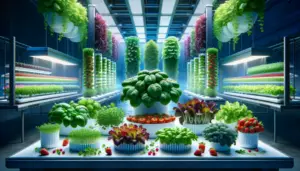Hydroponics has revolutionized the way we grow crops, allowing for higher yields, faster growth rates, and more efficient use of resources. This soil-less farming method offers numerous advantages, including the ability to control environmental conditions, reduce pest and disease pressures, and grow crops year-round. However, one of the most critical questions for anyone considering hydroponic farming is: What is the most profitable hydroponic crop to grow? In this comprehensive guide, we will explore various hydroponic crops and determine which ones offer the highest profitability. We’ll consider factors such as market demand, growth cycles, and the costs involved in cultivation.

Understanding Hydroponics
Before delving into the most profitable crops, it’s essential to understand what hydroponics is and why it’s becoming increasingly popular. Hydroponics is a method of growing plants without soil, using mineral nutrient solutions in an aqueous solvent. The roots are supported by an inert medium such as perlite, vermiculite, or coconut coir. This method allows plants to grow faster and with higher yields compared to traditional soil-based farming.
Advantages of Hydroponics
-
Higher Yields: Hydroponic systems can produce higher yields than traditional farming methods due to the optimized delivery of nutrients and water.
-
Faster Growth Rates: Plants grown hydroponically often grow faster because they have direct access to nutrients and oxygen.
-
Water Efficiency: Hydroponic systems use less water than soil-based systems because water is recirculated and reused.
-
Pest and Disease Control: The controlled environment of hydroponics reduces the risk of pests and diseases.
-
Year-Round Production: Hydroponic farming can be done indoors or in greenhouses, allowing for year-round crop production regardless of external weather conditions.
Types of Hydroponic Systems
There are several types of hydroponic systems, each with its own advantages and suitability for different crops:
-
Nutrient Film Technique (NFT): A shallow stream of nutrient-rich water recirculates over the roots.
-
Deep Water Culture (DWC): Plants are suspended in a nutrient-rich water solution, providing constant access to oxygen and nutrients.
-
Aeroponics: Roots are misted with a nutrient solution, offering high oxygenation.
-
Wick Systems: Nutrients are drawn up through a wick from a reservoir to the plant roots.
-
Ebb and Flow (Flood and Drain): Plants are periodically flooded with nutrient solution, which then drains away.
-
Drip Systems: Nutrient solution is dripped directly onto the base of each plant.
Factors to Consider When Choosing a Hydroponic Crop
To determine the most profitable hydroponic crop, several factors need to be considered:
-
Market Demand: Understanding consumer preferences and market trends is crucial.
-
Growth Cycle: Crops with shorter growth cycles can be harvested more frequently, increasing profitability.
-
Yield per Square Foot: High-yielding crops can maximize the use of available space.
-
Selling Price: The market price of the crop significantly impacts profitability.
-
Cultivation Costs: Consider the costs of seeds, nutrients, energy, and labor.
Most Profitable Hydroponic Crops
1. Lettuce
Lettuce is one of the most popular and profitable hydroponic crops due to its high demand and relatively short growth cycle. It can be grown using various hydroponic systems, including NFT, DWC, and aeroponics.
Benefits of Growing Lettuce:
-
Short Growth Cycle: Lettuce can be harvested in as little as 30 days, allowing for multiple harvests per year.
-
High Market Demand: Lettuce is a staple in salads and sandwiches, ensuring consistent demand.
-
Low Maintenance: Lettuce requires minimal intervention, making it ideal for beginners.
Varieties of Lettuce:
-
Romaine: Popular for its crunchy texture and high nutritional value.
-
Butterhead: Known for its soft leaves and mild flavor.
-
Leaf Lettuce: Includes varieties like red leaf and green leaf, which are popular in salads.
2. Basil
Basil is another highly profitable hydroponic crop, valued for its culinary and medicinal uses. It grows quickly and can be harvested multiple times from the same plant.
Benefits of Growing Basil:
-
High Market Value: Fresh basil commands a high price in the market, especially in gourmet and organic segments.
-
Fast Growth: Basil can be harvested in about 28 days from planting.
-
Multiple Harvests: Basil plants can be pruned and harvested several times before they need to be replaced.
Popular Varieties of Basil:
-
Genovese: Widely used in Italian cuisine for making pesto.
-
Thai Basil: Essential in Southeast Asian dishes.
-
Lemon Basil: Offers a citrus flavor, popular in teas and salads.
3. Spinach
Spinach is a nutritious leafy green that grows well in hydroponic systems. It has a relatively short growth cycle and high market demand.
Benefits of Growing Spinach:
-
Nutritional Value: Spinach is rich in vitamins and minerals, making it a popular health food.
-
Quick Growth: Spinach can be harvested in 30-40 days.
-
Year-Round Demand: Spinach is used in salads, smoothies, and cooked dishes, ensuring consistent demand.
4. Strawberries
Strawberries are a lucrative hydroponic crop due to their high market value and demand for fresh, high-quality berries.
Benefits of Growing Strawberries:
-
High Market Price: Fresh strawberries can fetch a high price, especially if grown organically.
-
Continuous Production: With the right conditions, strawberries can produce fruit throughout the year.
-
Space Efficiency: Hydroponic systems can be designed to grow strawberries vertically, maximizing space use.
5. Microgreens
Microgreens are young vegetable greens that are harvested shortly after the seeds germinate. They are used as a nutrient-dense garnish or salad ingredient.
Benefits of Growing Microgreens:
-
Fast Turnaround: Microgreens can be harvested in 7-21 days.
-
High Market Value: Microgreens are sold at a premium price due to their health benefits and culinary uses.
-
Minimal Space Requirements: They can be grown in small trays, making them ideal for urban farming.
6. Tomatoes
Tomatoes are a staple in many diets and can be highly profitable when grown hydroponically. They require more maintenance and space but can yield high returns.
Benefits of Growing Tomatoes:
-
High Yield: Hydroponic tomatoes can produce large quantities of fruit.
-
Year-Round Production: Tomatoes can be grown year-round in controlled environments.
-
Versatility: Used in a wide range of dishes, ensuring high demand.
7. Cucumbers
Cucumbers are another profitable hydroponic crop, known for their high yields and fast growth rates.
Benefits of Growing Cucumbers:
-
Fast Growth: Cucumbers can be harvested in 50-70 days.
-
High Yield: Hydroponic systems can produce large quantities of cucumbers.
-
Market Demand: Cucumbers are widely used in salads, sandwiches, and pickles.
8. Peppers
Peppers, including bell peppers and hot peppers, are valuable hydroponic crops with high market demand.
Benefits of Growing Peppers:
-
High Market Value: Both sweet and hot peppers command good prices.
-
Diverse Varieties: A wide range of colors, flavors, and heat levels are available.
-
Continuous Harvest: With proper care, pepper plants can produce fruit over an extended period.
9. Kale
Kale is a highly nutritious leafy green that has gained popularity due to its health benefits. It grows well in hydroponic systems and has a steady market demand.
Benefits of Growing Kale:
-
Nutritional Value: Kale is rich in vitamins, minerals, and antioxidants.
-
Year-Round Production: Kale can be grown throughout the year in hydroponic systems.
-
Market Demand: Kale is popular in salads, smoothies, and health foods.
10. Herbs (Mint, Cilantro, Parsley)
Herbs are a versatile and profitable category of hydroponic crops. They are used in various culinary dishes and have a steady market demand.
Benefits of Growing Herbs:
-
High Market Value: Fresh herbs are sold at premium prices.
-
Fast Growth: Many herbs can be harvested within a few weeks.
-
Continuous Harvest: Herbs can be pruned and harvested multiple times.
Factors Influencing Profitability
Market Research
Understanding the local and global market demand for specific crops is crucial. Conduct thorough market research to identify trends and preferences.
Quality Control
Maintaining high-quality produce is essential for profitability. Ensure that your hydroponic system is well-maintained and that plants are healthy.
Marketing and Distribution
Develop a robust marketing strategy to reach potential customers. Consider selling directly to consumers, restaurants, or through farmers’ markets.
Energy and Resource Management
Optimize energy use and resources to reduce costs. Invest in energy-efficient lighting and automation systems to manage your hydroponic farm efficiently.
Scale and Expansion
Consider scaling up your operations to increase profitability. Larger systems can produce more crops, spreading the fixed costs over a larger production base.
Recommended Hydroponic Systems and Products
Investing in high-quality hydroponic systems and products can significantly enhance your farm’s productivity and profitability. Here are some top recommendations:
-
NuAqua Systems
NuAqua Systems offers advanced reverse osmosis systems that ensure clean and balanced water for your hydroponic plants. Their systems are designed to remove contaminants and provide pure water, crucial for maintaining optimal plant health. Discover NuAqua Systems for reliable water filtration solutions. -
Lettuce Grow Farmstand
The Lettuce Grow Farmstand is an excellent self-watering and self-fertilizing vertical garden system. It is perfect for both indoor and outdoor use and allows you to grow a variety of crops effortlessly. Shop the Farmstand to find the perfect size for your needs. -
Growace Complete Home Kit
This comprehensive grow kit from Growace includes everything you need for a successful indoor hydroponic setup. It features high-quality grow lights, a tent, a ventilation system, and all necessary accessories. Using filtered water with this system can enhance performance and plant growth. Check out the complete kit to start growing your plants indoors efficiently.
Conclusion
Determining the most profitable hydroponic crop depends on various factors, including market demand, growth cycles, yield, and cultivation costs. Lettuce, basil, spinach, strawberries, microgreens, tomatoes, cucumbers, peppers, kale, and herbs are among the most profitable hydroponic crops. Each crop has its unique benefits and market potential.
By conducting thorough market research, maintaining high-quality produce, and investing in efficient hydroponic systems, you can maximize profitability in your hydroponic farming venture. Whether you are a beginner or an experienced grower, choosing the right crops and employing best practices will help you achieve success in hydroponic farming.
For more tips, products, and community support, visit Vertical Farming Planet. Join us in our mission to promote sustainable living and innovative gardening techniques.
